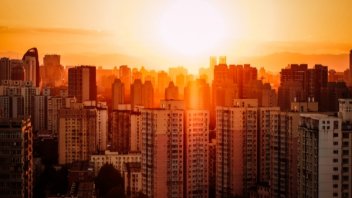Paris takes green building to heart
With sustainable new developments in the works and a raft of initiatives to make existing buildings more environmentally friendly, Paris is giving itself a green makeover.
One of the most densely populated cities in Europe, Paris has seen its pollution levels soar due to cars, building emissions and modern urban living.
Now it’s implementing an ambitious strategy to reduce emissions and energy use by 25 percent by 2020 – as set out in its new Plan Climat Energie Territorial (PCET).
Sustainable buildings, including those with better energy efficiency along with green roofs, living walls and rooftop gardens, have a key role to play in achieving its goal.
“Global warming has become more of a priority,” says Virginie Houzé, director of research at JLL France. “Paris has made it one of its flagship projects and sustainable building is contributing to the effort. It’s also proving popular with local people who want to see more greenery amid all the concrete of the city.”
Public and private groups are coming together to bring more greenery to the city’s buildings and develop urban agricultural projects. In 2016, the mayor of Paris signed the plan Objectif 100 hectares along with 33 other parties, paving the way for a 2017 platform, Végétalisons Paris, which aims to introduce more green spaces within the city, including 100 hectares of greenery on walls and roofs by 2020.
Going a step further
Simply adding plants to building facades doesn’t make a building sustainable. Instead, companies are turning to certification systems such as ‘Habitat et Environnement’ in France or BREEAM in the UK which evaluate the environmental quality of the building.
“Everyone knows that new buildings should be environmentally friendly – and even though certifications aren’t obligatory, no developer nowadays would construct a building without them,” says Houzé. “In fact, property sellers often go the other way and aim for numerous certifications to better appeal to investors from both France and abroad.”
However, while it’s relatively straightforward for new developments to comply with environmental standards, it’s harder to adapt older buildings. That’s a particular problem for Paris, as it is in the rest of France, where buildings are old and convincing the owners to carry out the necessary work is often a major obstacle – especially for residential housing.
“Many owners bought their apartment or house many years ago and now they don’t see why they should spend tens of thousands of euros to meet current sustainable building standards. Often, they don’t do anything to address the issue,” says Houzé. “One big challenge is therefore to help owners to adopt current and future norms for sustainable buildings.”
Numerous financial incentives have been put in place to do just that. In April, the French government outlined its plan to improve energy consumption in homes through its 2018 finance bill. It aims to renovate 250,000 private homes a year through tax credits, eco-loans at zero percent interest and energy efficiency certificates.
When it comes to commercial real estate, the incentives are different – and demand for improvements often comes from the building’s tenants.
“Many companies have CSR initiatives in place which include commitments to energy consumption and sustainable development,” says Houzé. “They’re looking for premises that fit with their policies – and in many in cases this is driving investors to renovate real estate to meet their needs.”
Nevertheless, she adds, it takes time to for the owners of residential or commercial buildings to meet modern sustainability standards. In the meantime, public authorities continue to focus largely on new build properties.
The heritage aspects of Paris’ old buildings provide a further challenge. With local authorities particularly strict about preserving the buildings at the heart of the city, adding either internal or external features that make them more sustainable is difficult.
“There are rules around the external appearance of the buildings,” says Houzé. “These define areas such as height and style of windows. While we are seeing more and more innovative sustainable projects, it will take time for them to find their place in the capital.”
Creating a positive image
The first signs of change are already happening. In response to a recent competition to ‘invent the metropolis of greater Paris’ , the winning entry proposed a vertical village built of timber as the gateway to the suburb of Rosny-sous-Bois. Meanwhile, the Tour Montparnasse is getting a green makeover in time for the 2024 Olympics with plants of its lower walls and a conservatory on top and in Charenton-Bercy, plans are afoot for a zero-energy 180-metre skyscraper that could be one of Europe’s most sustainable buildings.
Other projects are taking the concept of sustainability a step further with entire eco-districts. The Clichy-Batignolles development, which is aiming for completion by 2020, is setting new standards in sustainable urban design in France and Europe including energy efficiency.
Such projects are positioning Paris as a pioneer in the space, befitting for a host city of the international climate agreements. “We’re at the heart of an extremely ambitious agreement, which has huge global ramifications for the environment so we should lead by example,” says Houzé. “But apart from that, these projects are a big opportunity to show how Paris can regenerate itself.”
While greener buildings alone can’t completely reduce emissions and energy use in the French capital, the move towards more sustainable development represents a big step forward – and encourages other cities to follow suit.
















